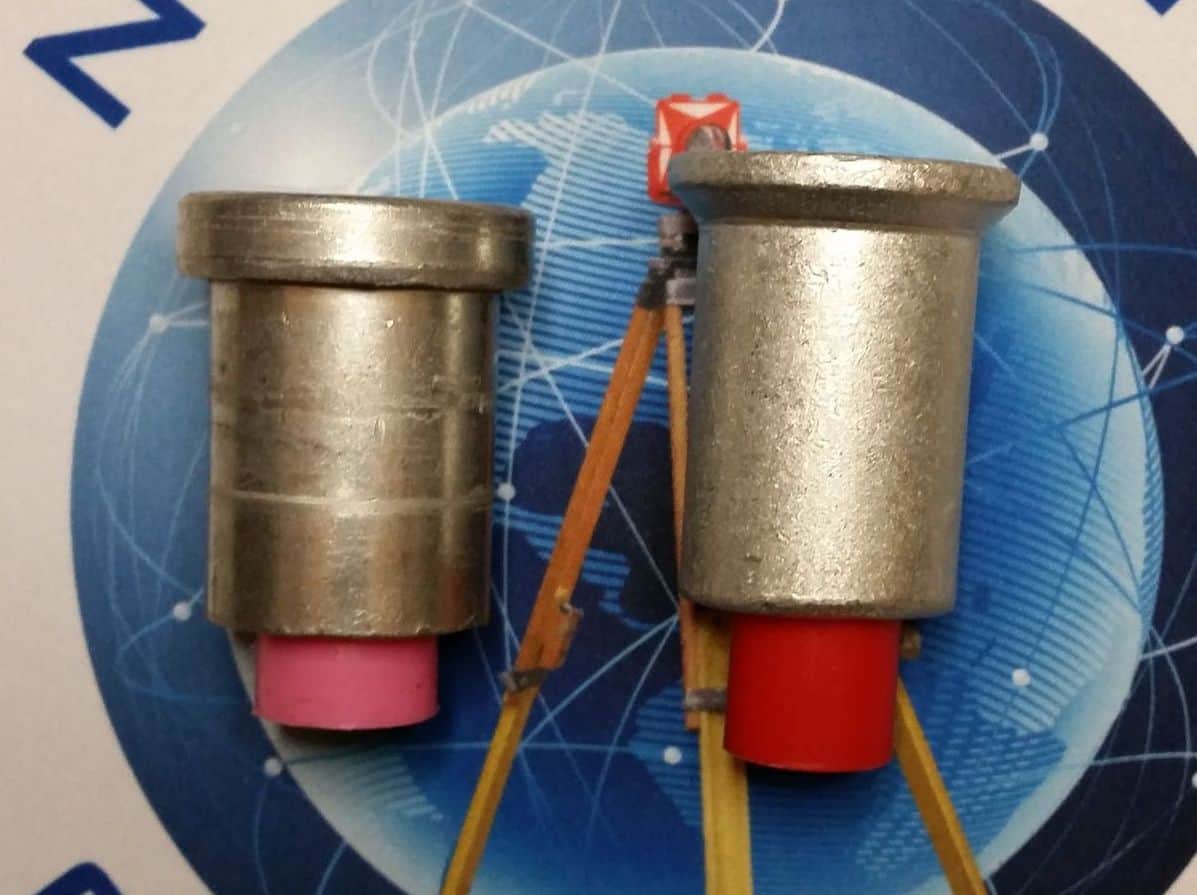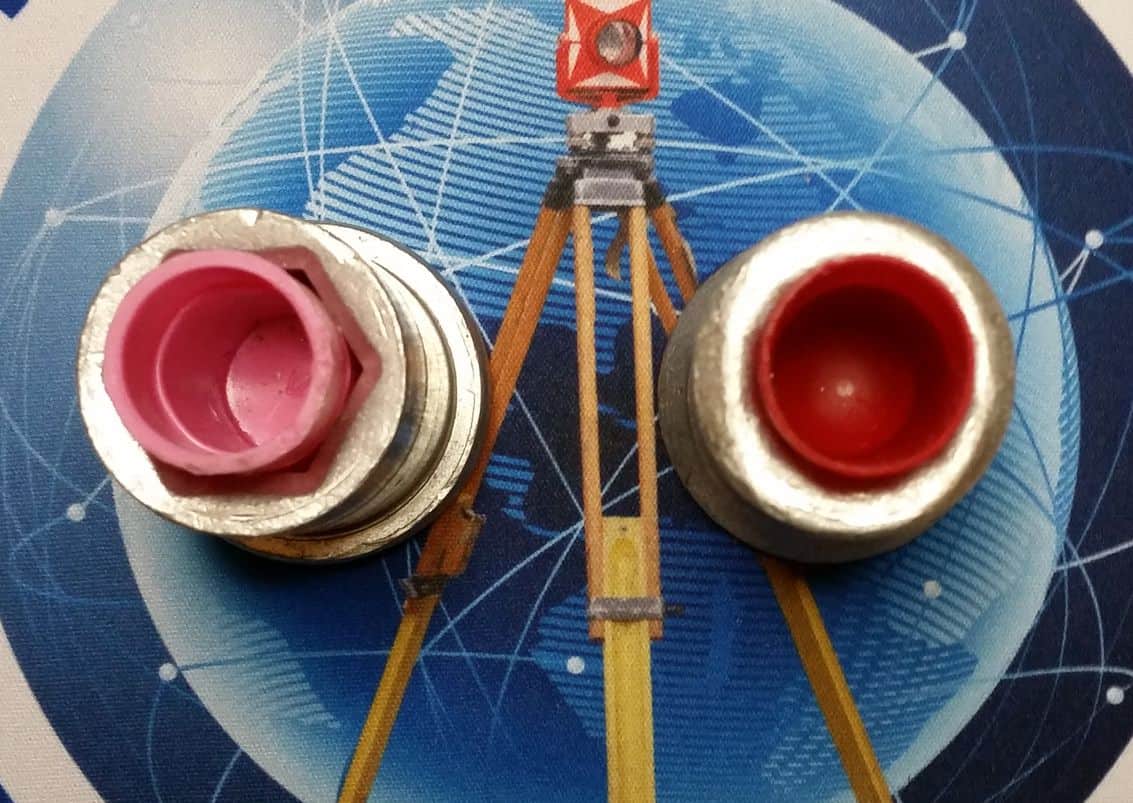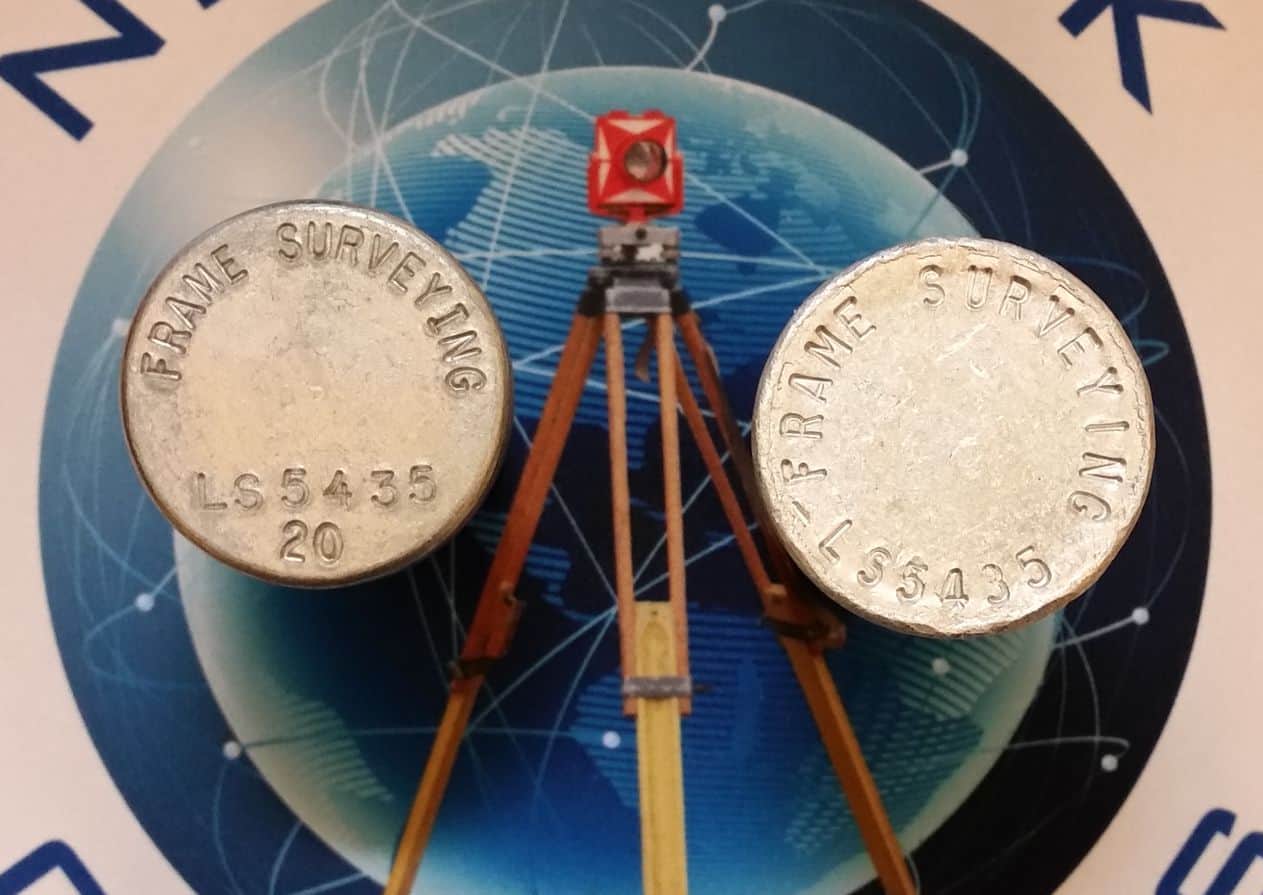I've been a Berntsen customer for many years, but I recently decided to take a look at Surv-Kap. The photos below compare the 1-1/2" caps for 5/8" rebar from each manufacturer.
The side view doesn't reveal any material difference aside from style. I can't say I have a preference.
The bottom view shows that the Berntsen cap (on the left) has a much thicker poly insert. This might have a significant effect on grip, but I haven't done any testing.
Then there's the matter of stamping. Berntsen definitely has the edge here; the top is smooth and the stamping crisp. The Surv-Kap top is a bit uneven around the edges, with a slightly rougher surface, which makes the stamping look a bit less sharp even though it's very nearly the same as the Berntsen. (The Berntsen has been rolling around in my truck for a couple of years, which means the stamping picked up a bit of dirt that makes it stand out in the photo. The Surv-Kap is brand new, just out of the box today.)
Finally, there's the matter of cost, and that's what led me to try Surv-Kap: in quantities of 25 or more, the Surv-Kap is half the cost of the Berntsen.
I don't plan to leave Berntsen behind, as I've bought a lot of really high-quality materials and tools from them over the years, and gotten excellent service every time. But I'm going to give the Surv-Kap caps a try, because the cost difference is too much to ignore.
Jim Frame, post: 403008, member: 10 wrote: But I'm going to give the Surv-Kap caps a try, because the cost difference is too much to ignore.
damn low-ballers.
I have in the past (multiple times, when working with DOTs) been required to provide certifications of origins for material. Berntsen has provided this certification that all their material is USA products 100%. I Don't know about Surv-Kap, but at 50% cheaper, I can think of one place the material may be coming from.
I would hate to remove 200+ ROW and/or Centerline dics at my cost for using foreign non-US material all because I saved 150 dollars.
Sounds crazy, but these things matter when public money is involved.
I remember when Berntsen used thin plastic inserts. They were not forgiving with rebar with large ribs or slight mushroom. the insert would crush and not seat properly. I appreciate the thick insert for this reason.
Is the surv-cap insert as thin as it looks? Or is there a flare? Or both?
Bob Freeman, post: 403026, member: 460 wrote: Is the surv-cap insert as thin as it looks? Or is there a flare? Or both?
It's as thin as it looks.
Is the "pink pentagon" in the Berntsen also plastic? Does the Surv-Kap have anything similar?
BajaOR, post: 403083, member: 9139 wrote: Is the "pink pentagon" in the Berntsen also plastic? Does the Surv-Kap have anything similar?
What you describe is just the pink plastic insert reflected in the chamfered hexagonal opening in the aluminum cap.
I did surv-kap for a small batch of custom caps for a landowner. I was not impressed with the stamping or the roughness of the appearance on surv-kap.
I use Bernsten exclusively now. I should post a similar comparison photo...I just need to find the spare cap I had made "just in case".
Many thanks to Jim for taking the time to evaluating our rebar caps. It brought out a good discussion about the details of our cap design. Durability and longevity are the reasons for the way our caps are manufactured. The combination of plastic thickness and hex shape provide long-term benefits. Since the actual size of rebar can fluctuate among the industry, the hex shape will provide space for secure grip, while the thickness and flexibility of our plastic prevents cracking and ensures a long-lasting monument. We pride ourselves in our quality service and product and it is great to be part of an industry that recognizes that.
Jim Frame, post: 403008, member: 10 wrote: Finally, there's the matter of cost, and that's what led me to try Surv-Kap: in quantities of 25 or more, the Surv-Kap is half the cost of the Berntsen.
I don't plan to leave Berntsen behind, as I've bought a lot of really high-quality materials and tools from them over the years, and gotten excellent service every time. But I'm going to give the Surv-Kap caps a try, because the cost difference is too much to ignore.
I've used a similar type of Surv-Kap marker, a 2-inch Aluminum Cap with 5/8-inch insert for rebar for about 25 years and have had an opportunity to see how well they have performed in actual use in Texas. The rod and cap seen above was one I set in 1992, but is identical to that I use currently. I've never used the Berntsen products, but I know that my late survey friend Charles Swart switched to Surv-Kap after using Berntsen re-bar caps for years.
It is true that if you are buying rebar for installation with caps, it's a good idea to look at the rebar in the yard and chorse sticks of it that do not have longitudinal ribs that project beyond the transverse deformations. You can grind those ribs off, but it's easier to buy rebar that are as nearly round in cross-section as possible. I buy my #5 bars at a lumber yard in 20 ft. lengths and cut them into three pieces for transport. In Central Texas, the length of rebar that will be needed can vary from 12 inches to 72 inches, so it's handy to cut them to length as needed.
The field method to knock the projecting ribs down is just to lay the bar on a the side of the head of a sledge for an anvil and use a lighter hammer to pound the longitudinal ribs down along what will be the upper segment of the bar that the cap affixes to. It's the work of 30 seconds or less to round off the cross section by flattening the projecting ribs and much less hassle than grinding them.
Another important tip is to use a drive cap when driving the rebar similar to the sort that Surv-Kap sells. It rounds over the edges of the cut end of the bar and that makes for a better installation as well.
Probably the weak link with plastic inserts is if they degrade from exposure to the atmosphere over time. I've removed Surv-Kap caps from rods that I set more than 20 years ago and have seen that while the exposed fringes of the plastic insert (the lower 3/16 inch or so) were degraded a bit, the rest of the insert that had been protected by the aluminum cap was fresh. In fact, That was a rod and cap that had been set with the bottom of the cap above grade. Had it been in the ground, the same effect would most likely not apply. I recently used the older insert of a cap I set in 1992 to reinstall a cap that I found had been hit by machinery in a way that bent the rod (but didn't remove the cap). With tools and some effort, I pulled the cap off the rebar, straightened the rebar, and reset the cap, reusing the old plastic insert. I was impressed by how well the plastic had held up.
One trick to use when installing the Surv-Kap caps is to convert one of the caps into a drive cap by just pulling the plastic insert out, placing the cap upside down on the cap to be seated on a rod, and using the inverted cap as a drive cap, no special hammer needed. Have used this method for more than twenty years and would recommend.
I have also been using Surv-Kap monuments for decades, although I use more "Pipe/Cap" monuments than ReBar Caps (usually). The ReBar Caps that I use are their 2å? and 3å? inch Domed Caps, and I have been very pleased with these items. As Kent indicated above, for best results (with ANY Rebar cap), a little attention to detail with the ReBar is important. I also use their 3å? inch Domed "stem" Caps for serious Control Stations in Bedrock.
Loyal
Jim Frame, post: 403091, member: 10 wrote: What you describe is just the pink plastic insert reflected in the chamfered hexagonal opening in the aluminum cap.
I see now (found my glasses). D'oh.
Kari Campbell, post: 403145, member: 12306 wrote: Many thanks to Jim for taking the time to evaluating our rebar caps. It brought out a good discussion about the details of our cap design. Durability and longevity are the reasons for the way our caps are manufactured. The combination of plastic thickness and hex shape provide long-term benefits. Since the actual size of rebar can fluctuate among the industry, the hex shape will provide space for secure grip, while the thickness and flexibility of our plastic prevents cracking and ensures a long-lasting monument. We pride ourselves in our quality service and product and it is great to be part of an industry that recognizes that.
Has anyone ever considered making an aluminum cap without the lip at the top. I realize this gives a little more space to write/less material cost, but in my corner of the frozen tundra I often hook them with my jackhammer bit and pop them off. Obviously the same can happen with plastic, but it's more difficult than the aluminum caps.
Steve
sjc1989, post: 403249, member: 6718 wrote: Has anyone ever considered making an aluminum cap without the lip at the top. I realize this gives a little more space to write/less material cost, but in my corner of the frozen tundra I often hook them with my jackhammer bit and pop them off. Obviously the same can happen with plastic, but it's more difficult than the aluminum caps.
Steve
You are correct. Berntsen manufactures this style of cap to provide a larger stamping space and lower material costs. Thank you for the input. We are always researching and testing our products to make sure they have optimal use efficiency. I will make sure to pass on this information to our production team.
Last year I decided to switch from plastic caps to aluminum. I bought a box of Bernstein and a box of Surv-Kap for 5/8 rebar, the exact caps Jim Frame photographed. By far we preferred the Bernstein. They looked better and went on easier. Even though they do cost more they look very impressive, and for an extra dollar they are worth it. Also we've been using a small rubber mallet to install them. It doesn't continue to drive the rebar down, and doesn't damage the lettering.
Surve-kap: 1-1/2" & 2" aluminum w/o inserts for rebar, 3" aluminum cap with inserts for rebar, 3" aluminum and brass caps w/o inserts for aluminum rods.
Have to have the rebar pointed and beveled.
The aluminum rods are pointed and sometimes cut off with hacksaw.
Bill68, post: 403357, member: 10680 wrote: I bought a box of Bernstein and a box of Surv-Kap for 5/8 rebar, the exact caps Jim Frame photographed. By far we preferred the Bernstein. They looked better and went on easier. Even though they do cost more they look very impressive, and for an extra dollar they are worth it. Also we've been using a small rubber mallet to install them. It doesn't continue to drive the rebar down, and doesn't damage the lettering.
The real test of any marker will be twenty years from now when it is revisited. I would think that neither the Surv-Kap or the "Bernstein" markers are exempt from requiring that the rebars be adequately prepared before affixing the cap, so If the Bernsteins went on "easier" with no preparation of a re-bar, that would make me think that the thick polyethylene inserts were all that really attached the cap and questions of long-term permanence would arise.
The obvious first test would be to check the mechanical connection by measuring the strength of the attachment. both as to axial pull force as well as to dislodgement by jarring, the test that I'd use would be the simple one of how easy it is to remove the cap with an ordinary tool like a 24 oz. claw hammer.
I would myself consider the ease of field stamping to be a critical feature. That is, the question would be which marker is the easier one to add field stampings like pt. i.d. nos. to. I find it easier to add stampings to caps after they have been affixed to rebars and would test both caps under those conditions. My recollection of some of the early Bernstein caps I've seen in the field was that the alloy was a bit brittle. At any rate, the 3-1/2 in. rod caps I remember were obvlously broken rather than merely deformed as one I would expect of the alloy used in the Surv-Kap markers. It may well be that Bernstein has changed alloys or manufacturing process in the last twenty years.






